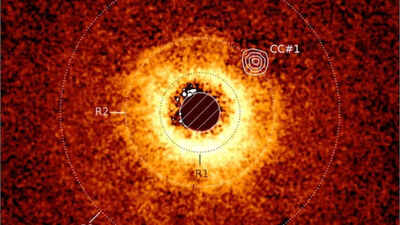
The
James Webb Space Telescope
has officially discovered its first new planet after three years of supporting astronomers in studying known exoplanets. This young world is a groundbreaking discovery designated TWA 7b because it is the lowest-mass planet ever directly imaged outside the solar system. With an estimated mass of just 0.3 times that of Jupiter (or about 100 times that of Earth), TWA 7b is ten times lighter than any previously directly imaged exoplanet.
James Webb Space Telescope captures young exoplanet TWA 7b
The young exoplanet discovered by JWST: TWA 7b orbits a young, low-mass star called CE Antliae (also known as TWA 7), located approximately 111 light-years from Earth in the constellation Antlia. This star, discovered in 1999, is part of the TW Hydrae Association, a group of stars known for their youth. CE Antliae is thought to be just 6.4 million years old—a cosmic infant compared to our 4.6-billion-year-old Sun. Its youthful nature, along with its nearly pole-on orientation as seen from Earth, made it an ideal candidate for imaging with JWST.
How James Webb Space Telescope spotted a new planet hiding in a dusty ring
The key to discovering TWA 7b lies in infrared imaging. Young, low-mass planets like TWA 7b emit thermal radiation in the infrared spectrum, which is JWST’s specialty. The telescope’s Mid-Infrared Instrument (MIRI), along with its coronagraph, played a pivotal role.A coronagraph allows astronomers to block out the overwhelming light of a star, making it possible to detect faint nearby objects such as exoplanets. Using high-contrast imaging techniques, the JWST team was able to detect a faint infrared source embedded in the debris disc around TWA 7.This faint source turned out to be located in a gap between rings of dust—an area theorised to be carved out by a planet’s gravitational influence. Simulations confirmed that the presence of a Saturn-mass planet in that exact location could explain the observed structure.
James Webb Space Telescope finds TWA 7b in a dust gap
The disc around TWA 7 is not a random cloud of debris—it contains three distinct rings, with gaps in between. One of these gaps has a narrow ring flanked by two dust-free regions, a signature commonly associated with the gravitational forces of an orbiting planet. The infrared glow detected by JWST corresponds precisely to this ring gap, and its brightness, temperature (around 320 Kelvin or 47°C), and orbital distance (about 50 astronomical units from the star) all match what scientists expected of a planet in this region.
What makes this discovery so significant
The discovery of TWA 7b marks a milestone in exoplanet science for several reasons:
- First planet discovered by JWST using direct imaging
- Lowest-mass exoplanet ever directly imaged
- Potential first observational evidence of a planet influencing a debris disc
- New insights into planet formation in very young systems
Astronomers believe that the structures seen in debris discs around young stars are blueprints for planetary formation. These rings and gaps represent zones where material is either accumulating to form planets or being cleared out by their gravitational pull. TWA 7b may be the first direct proof of this process in action.
How James Webb Space Telescope new imaging techniques revealed the hidden planet TWA 7b
To detect TWA 7b, researchers used advanced image subtraction methods. Removing residual starlight, they could separate the planet from Solar System bodies and background galaxies. This finding illustrates the way that new observing methods and instruments on JWST—such as the coronagraph and MIRI—are opening up our ability to discover hitherto inaccessible exoplanets. Due to JWST's mid-infrared sensitivity, it's now able to detect planets as massive and as cold as Saturn, a tremendous improvement in direct imaging.
Future of exoplanet discovery with James Webb Space Telescope
With its ability to suppress starlight and pick up the faint heat signatures of small, cold planets, JWST is opening a new frontier in exoplanet discovery. Astronomers are now optimistic that even lighter planets—possibly Neptune-mass or even super-Earths—could soon be within reach.Future follow-up observations will aim to:
- Confirm the planetary nature of TWA 7b
- Measure its exact mass, atmosphere, and temperature
- Study the dynamic interactions between the planet and its debris disc
- Look for Trojan dust clouds—collections of material that may share the planet’s orbit.

 7 hours ago
48
7 hours ago
48




























 English (US)
English (US)